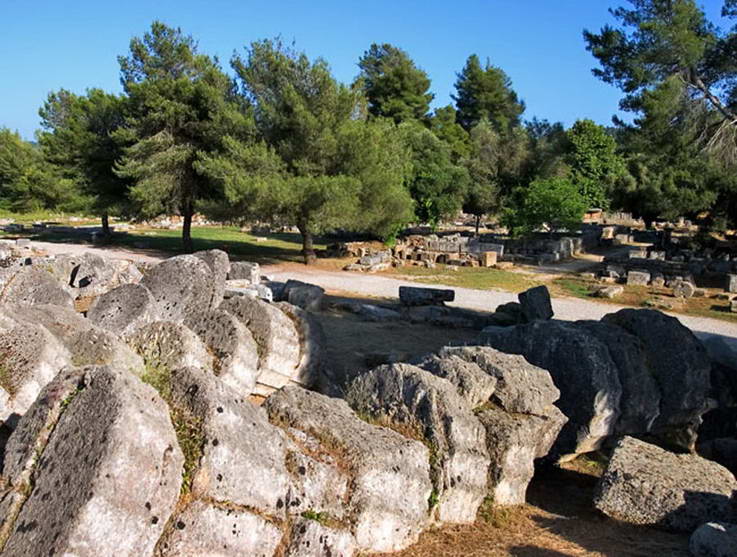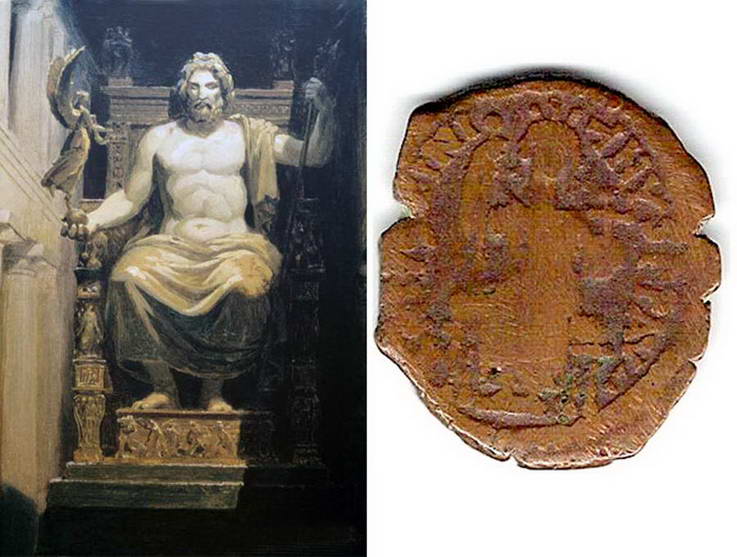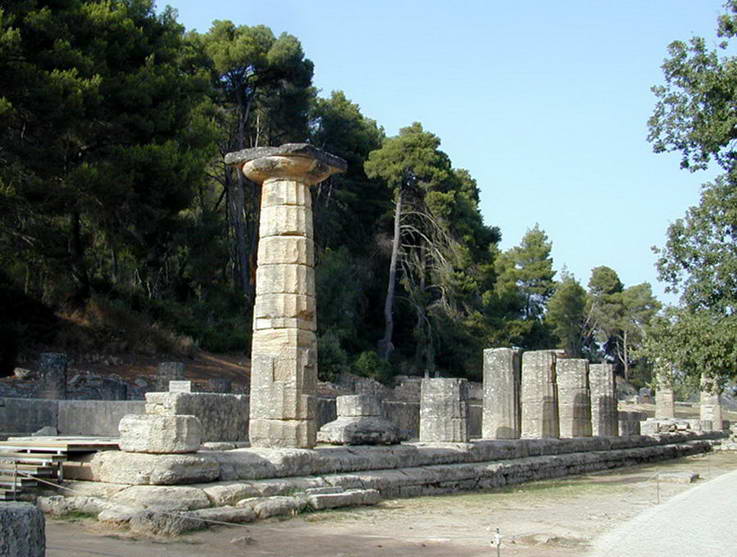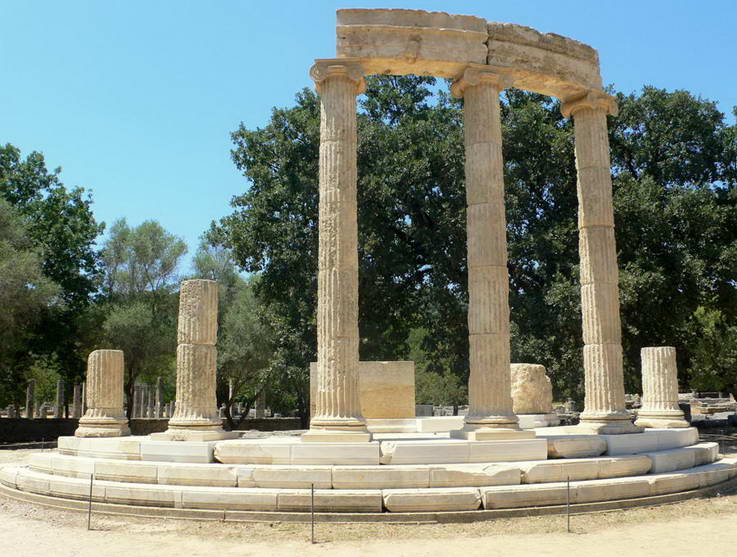Description
Temple of Zeus at Olympia
The massive temple of Zeus, the most important building in the Altis, standing in its very centre, is the largest temple in the Peloponnese, considered by many to be the perfect example of Doric architecture. It was built by the Eleans from the spoils of the Triphylian war and dedicated to Zeus. Construction began c. 470 and was completed before 456 BC, when an inscribed block was let into the east gable to support a gold shield dedicated by the Spartans in commemoration of their victory at Tanagra. The architect was Libon of Elis; the sculptor of the pediments is unknown.
Temple of Зera at Olympia
The temple of Hera, one of the oldest monumental temples in Greece, stands in the north-west corner of the sacred precinct of the Altis, on the south slopes of Kronios hill, protected by a powerful terrace wall. It was dedicated to the Olympian sanctuary by the inhabitants of Skillous, an ancient city of Eleia. Pausanias relates that the temple was built approximately eight years after Oxylos ascended to the throne of Elis, that is c. 1096 BC, but in reality it is much later. According to some scholars, the first Heraion, built around 650 BC, was a small Doric temple with only a cella and pronaos, to which the opisthodomos and ptero were added later, around 600 BC. However, the theory that the entire temple was built around 600 BC prevails today. The temple was refurbished on many occasions, and the Romans transformed it into a kind of museum for the sanctuary's choicest treasures, such as the famous Hermes by Praxiteles.
Altar of Hera at Olympia
East of the Heraion, directly in front of the temple, are the foundations of the altar of Hera. This small oblong structure of poros, 5.80 metres long and 3.50 metres wide, was probably built like the temple in the sixth century BC to replace an earlier altar formed by the ashes of the sacrificed animals.
The Olympic flame of the modern Olympic games is lit on this very altar. The ceremony was first held for the 1936 Berlin Olympic games and has been repeated ever since for each Olympiad.
Philippeion
The Philippieion, the only circular building inside the Altis, is one of the finest examples of ancient Greek architecture. Located west of the temple of Hera, it was dedicated to Zeus by Philip II of Macedon after his victory at Chaironeia in 338 BC, proving the important political role of the sanctuary at that time. After Philip's death in 336 BC, the monument was completed by his son, Alexander the Great, who had the statues of his family crafted by the famous sculptor Leochares, placed inside. The monument was also used for the worship of the deified royal family of Macedon.
The Metroon
The Metro?n, dedicated to the mother of the gods, Rhea, later re-named Cybele, stood east of the Heraion, below the terrace of the treasuries. This site was used for the worship of Mother Earth, to whom the sanctuary of Gaia was dedicated, and of Eileithyia, a similar deity connected to maternity, as early as the Prehistoric period.
The massive temple of Zeus, the most important building in the Altis, standing in its very centre, is the largest temple in the Peloponnese, considered by many to be the perfect example of Doric architecture. It was built by the Eleans from the spoils of the Triphylian war and dedicated to Zeus. Construction began c. 470 and was completed before 456 BC, when an inscribed block was let into the east gable to support a gold shield dedicated by the Spartans in commemoration of their victory at Tanagra. The architect was Libon of Elis; the sculptor of the pediments is unknown.
Temple of Зera at Olympia
The temple of Hera, one of the oldest monumental temples in Greece, stands in the north-west corner of the sacred precinct of the Altis, on the south slopes of Kronios hill, protected by a powerful terrace wall. It was dedicated to the Olympian sanctuary by the inhabitants of Skillous, an ancient city of Eleia. Pausanias relates that the temple was built approximately eight years after Oxylos ascended to the throne of Elis, that is c. 1096 BC, but in reality it is much later. According to some scholars, the first Heraion, built around 650 BC, was a small Doric temple with only a cella and pronaos, to which the opisthodomos and ptero were added later, around 600 BC. However, the theory that the entire temple was built around 600 BC prevails today. The temple was refurbished on many occasions, and the Romans transformed it into a kind of museum for the sanctuary's choicest treasures, such as the famous Hermes by Praxiteles.
Altar of Hera at Olympia
East of the Heraion, directly in front of the temple, are the foundations of the altar of Hera. This small oblong structure of poros, 5.80 metres long and 3.50 metres wide, was probably built like the temple in the sixth century BC to replace an earlier altar formed by the ashes of the sacrificed animals.
The Olympic flame of the modern Olympic games is lit on this very altar. The ceremony was first held for the 1936 Berlin Olympic games and has been repeated ever since for each Olympiad.
Philippeion
The Philippieion, the only circular building inside the Altis, is one of the finest examples of ancient Greek architecture. Located west of the temple of Hera, it was dedicated to Zeus by Philip II of Macedon after his victory at Chaironeia in 338 BC, proving the important political role of the sanctuary at that time. After Philip's death in 336 BC, the monument was completed by his son, Alexander the Great, who had the statues of his family crafted by the famous sculptor Leochares, placed inside. The monument was also used for the worship of the deified royal family of Macedon.
The Metroon
The Metro?n, dedicated to the mother of the gods, Rhea, later re-named Cybele, stood east of the Heraion, below the terrace of the treasuries. This site was used for the worship of Mother Earth, to whom the sanctuary of Gaia was dedicated, and of Eileithyia, a similar deity connected to maternity, as early as the Prehistoric period.
Published: 1 Jun. 2010
Add to favorite
- Information -
| odysseus.culture.gr |
| GPS Coordinates |
| 37.637877 , 21.630057 |
| 37° 38' 16,3572"N , 21° 37' 48,2052"E |
Where to stay
accommodations located nearby
More Holiday Ideas
what else you can see here around



